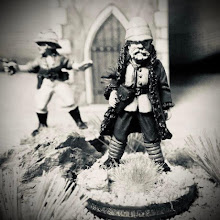Next unit up for my Indian Army for The Men Who Would be Kings is the 20th (Punjab) Regiment with all figures from Artizan Designs (UK/EU link and US Link). I feel I have my "speed painting" method down using GW Skeleton Horde Contrast for the khaki uniforms. As you can see above, for this unit I went with the alternative basing of "3", "2", "1". Of course they can be used for other popular Colonial rules.
The regiment was raised at Nowshera on 1 August 1857 by Lieutenant Charles Henry Brownlow from drafts provided by 4th and 5th Punjab Infantry on the orders of John Lawrence, the British High Commissioner of the Punjab. It was one of several battalions raised by Lawrence to suppress the Great Indian Mutiny of 1857. Brownlow, who became their first commanding officer, remained associated with the regiment for more than half a century; becoming their Honorary Colonel in 1904. He was made a Field Marshal in 1908.
The regiment's first overseas service came during the Second Opium War against China. Soon after landing there, it took part in the successful assault on Taku Forts on 21 August 1860. The regiment then advanced with the rest of the British force, arriving at Peking (Beijing) in late September, which was captured on 6 October. In 1861, the regiment was brought into the line as the 24th Regiment of Bengal Native Infantry, replacing the previous 24th which had mutinied in 1857. It was renumbered as the 20th Regiment later in the year.
In 1863, it took part in the Umbeyla Campaign on the North-West Frontier of India. During the fierce fighting at Crag Picquet in October and November, the 20th Punjabis retook the position, which had been captured by the tribesmen on 30 October. It then successfully defended the post from repeated attacks by the tribal forces. It was the first of many such engagements against the hostile Pashtun tribes of the Afghan frontier. In 1864, the regiment, now designated as the 20th (Punjab) Regiment of Bengal Native Infantry, took part in the Black Mountain Expedition, and in 1877, it operated against the Jowaki Afridis.
In 1891, after the Mir of Hunza refused to guarantee safe Btitish passage through his state, the 20th Punjabis participated in Colonel Algernon Durand's expedition to Hunza. In 1897, during a general uprising of Pashtun tribes, the regiment operated as part of the Mohmand Field Force. The regiment, under the command by Lieutenant-Colonel (later Lieutenant-General) JB Woon, fought in a fierce engagement against a force of about 6,000 Mohmands at Shabkadr. In 1900, the 20th Punjabis were sent to China to suppress the Boxer Rebellion.
Subsequent to the reforms brought about in the Indian Army by Lord Kitchener, the regiment's designation was changed to 20th Duke of Cambridge's Own Punjabis in 1903, and then 20th Duke of Cambridge's Own Infantry (Brownlow's Punjabis) in 1904.







_Bengal_Infantry_(6_Punjab),_Egypt_1882_2.jpg)



Very nice work on these Neil and an impressive regimental history, although doubtless some would see it as a shameful record of colonial repression....I am not one of them!
ReplyDeleteMost of the "shameful repression" I have read tend to be British that are "ashamed" of the past. Both good and bad came about in the Raj. It's been interesting to read Indian first hand accounts and modern Indian accounts. Thanks for the comments on the unit - I'm sure they will pick up some more battle honors!
DeleteNice figures great paint job.
ReplyDeleteThanks!
DeleteNeil
These grizzled veterans look smart in their khakis.
ReplyDeleteThanks Jonathan. That was exactly the look I was going for; not parade ground soldiers but troops that are experienced campaigners.
DeleteNeil
1922 - 2nd Battalion (Duke of Cambridge's Own) 14th Punjab Regiment.
ReplyDelete1947 - it was allocated to the Pakistan Army, where it continues to exist.
Good information - thanks!
Delete